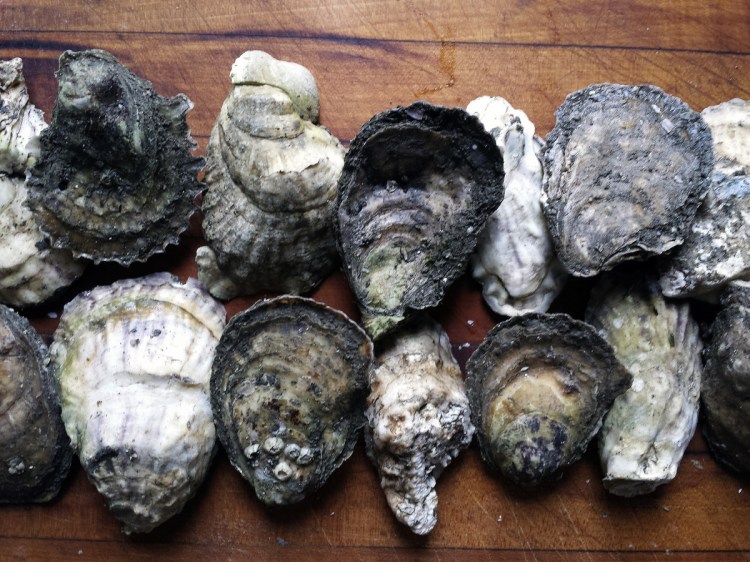I can’t really talk to my husband about ugly oysters. It galls his frugal nature that any foodstuff so luxuriously delicious would be eschewed based upon the appearance of its shell. Just think of how many great books would have gone unread by that principle, he pontificated professorially as he slurped down one of the ugly oysters I had roasted with butter laced with maple syrup and chipotle peppers on a recent Friday night for both this column and his delight. After all, he argued, as he sopped up the briny, buttery mix left in the pan with a piece of crusty bread, it’s what’s inside any oyster shell that matters.
Please don’t tell him I wrote this, but I think he may be right. Both in the water and in the kitchen, an ugly oyster offers the same services as a perfectly pretty one.
While alive and well in the water all oysters – regardless of their size or shape or whether they are wild or farmed (as most are today) – are filter feeders that provide an ecological service. They pull seawater into their systems and eat the phytoplankton in it, thereby removing nitrogen and phosphorous from the water. Oysters improve the quality of water for both the sea creatures and seaweed.
In the kitchen, oysters with wonky shells taste the same as lovely cupped ones grown in the same place using the same aquaculture method. But oyster growers take pains to prevent ugly oysters in the first place as consistently shaped, sized and colored oysters become their trademark in white-tablecloth restaurants where chefs and customers know them by sight.
Abigail Carroll’s Nonesuch Oysters are well-known for the lovely green tinge the shells pick up during the time they spend sitting on the bottom of the Nonesuch River estuary. The free-range life is a good one, but it’s also pretty hazardous, says Carroll. “We lose a lot of the (oysters) that are ground seeded in their second year,” Carroll said. To mitigate her risk, Carroll started putting some oysters in trays just above the bottom of the riverbed. She didn’t lose them, but they developed pearly white shells.
“But at some point, we needed those oysters for market so I took the ones that were most like the classic green Nonesuch and mixed them into the bags with the other oysters. Within 24 hours I had a call from an unhappy chef who was concerned that we’d harvested the oysters from another site. Not so, they were just farmed modestly differently on our own site,” said Carroll, who now markets the whiter ones finished in trays as Abigail Pearls. As for the ugly ones, they typically go home to dinner with Carroll’s staff.
Kit Paschal is the general manager at The Shop, the oyster bar that fronts the Massachusetts-based Island Creek Oyster wholesale operation on Washington Street in Portland. Island Creek pulls oysters from 10 lease sites in Duxbury Bay. The company uses long tubes called tumblers in which the growing oysters are periodically, well, tumbled, to break off bits of shell that might be growing in the wrong direction. The goal is deeply cupped, uniformly shaped oysters. The oysters that still appear misshapen after tumbling are returned to the leased growing sites where they are afforded the opportunity to become shapelier.
“But as some point, they become too large, take up space, and eat the food of the more marketable oysters, so they have to go,” Paschal explains. While there is a secondary market for large oysters in which they are shucked and canned, Island Creek opts to send them to New York. The company donates them to the Billion Oyster Project, a student-based nonprofit organization working to rebuild the natural oyster beds in New York Harbor. Typically, the project takes spent oyster shells from restaurants to rebuild the reefs because juvenile oysters need something upon which to anchor in order to grow to adulthood. Having live Island Creek elders in the mix serves double duty as they filter the water while waiting for younger oysters to glom onto them, Paschal said.
But Carroll says she’s starting to see more misshapen oysters in fish stores, too. And writer and American oyster expert Rowan Jacobsen says the oysters showing up on local happy hour menus for a buck a pop all over the Maine coast are most likely ones with nonconforming shells before they are relieved of the top one to be served in the bottom half on ice.
Carroll is hopeful the aesthetic tide is changing for oysters. “I think most people find the weird ones kind of interesting. I think we are moving beyond a world where oysters, and fruit, and people have to look perfect to be considered top quality. And that’s a good thing!”
CHRISTINE BURNS RUDALEVIGE is a food writer, recipe developer and tester and cooking teacher in Brunswick, and the author of “Green Plate Special,” a cookbook from Islandport based on these columns. She can be contacted at cburns1227@gmail.com.
Send questions/comments to the editors.


